Watts™ R-12
Whole House Reverse Osmosis
Questions?
Call us at (888) 382-3814
Please Note: Because of the nature of the products on this page, it's often best to get advice before you order.
For certain difficult waters, whole house reverse osmosis is sometimes not only the best solution, it is virtually the only solution. The most common application for large, point-of-entry reverse osmosis is water with high salt content. Reverse osmosis effectively removes sodium, chloride, fluoride and other difficult-to-treat contaminants.
Reverse osmosis has unique properties and solves problems that are often impossible for conventional filters. For a good list of percentage rejection figures for various contaminants, go here. Keep in mind that the list gives expected figures for small drinking water units, and the high pressure units described here usually perform a few percentage points better. Keep in mind, too, that carbon filtration can be used in conjunction with whole house reverse osmosis units and the carbon/reverse osmosis combination adds virtually all chemical contaminants to the list of items reduced.
Typical Whole House
Reverse Osmosis Setup
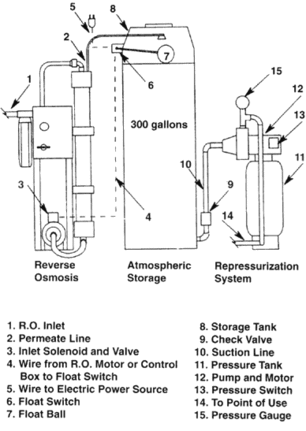
A Generic RO Unit
The system pictured above illustrates a complete system. This is a “generic” picture to illustrate the functioning of large reverse osmosis units in general. It is not a picture of the systems offered for sale on this page.
RO Terms
- Permeate: the product water of the RO unit, the water that's going to your home.
- Brine, also called Concentrate: The reject or drain water from the reverse osmosis unit.
- Check Valve: A one way valve. It lets water flow forward in the pipe but not backward.
- Solenoid: A switch that's turned on and off by electricity.
- Float Switch: A switch that turns on or off according to the level of the water it monitors.
- Pressure Tank: A tank that stores water under pressure and delivers it on demand without the help of a pump.
- Atmospheric Storage Tank: A tank that stores water at atmospheric pressure. In other words, an un-pressurized tank. Water must be pumped out.
- Pressure Switch: A switch that is activated by pressure. For example, it may be used to turn on a pump when pressure in a tank drops below 30 psi and turn it off when pressure rises to 50 psi.
- Point of Use: The place where the water will be used. For example, the home.
- TDS: Total Dissolved Solids. A measurement of an RO unit's performance efficiency.
Typically, a whole house system would include the following:
-
Pre-treatment for the RO unit, as needed. The reverse osmosis unit itself usually has only a small sediment prefilter. For some situations, where the water is good except for a high amount of sodium, for example, no additional pretreatment is needed. For most well water, however, the RO unit will need to be protected from sediment, iron, manganese, or hardness. This may require the use of a sediment filter, a water softener, an iron filter, or a sequestering additive (such a polyphosphate injection) as a pretreatment to protect the RO unit. RO units used on city water (for water vending or final rinse car wash applications, for example) will require carbon or carbon/KDF prefiltration to protect the RO unit from chlorine or chloramines.
-
A reverse osmosis unit to produce as much water as the household might need for a day. For example, a 600-gallon per day unit would be typical. A 600-gallon unit would produce usable water at the rate of about 25 gallons per hour. Since 25 gallons per hour is not enough to supply the demands of normal household functions such as laundry and showers, a storage system is needed so that ample water will be on hand when needed.
Keep in mind that the 600 gallon example is theoretical. A 600 gallon per day unit may produce much more or much less than 600 gallons per day. RO production depends on such variables as TDS (total dissolved solids) of the water treated and temperature of the water. RO units produce much faster when treating warm rather than cold water.
-
Storage tank and accessories. An atmospheric (non-pressurized) storage tank large enough to provide ample water for daily activities. The reverse osmosis unit refills the tank as water is taken from it. The water is stored at atmospheric pressure and must, therefore, be re-pressurized for use. The tank needs a few accessories, like bulkhead fittings to allow entry and exit of water, a float switch to tell the RO unit when more water is needed, and miscellaneous piping.
-
Repressurization system. This system can consist simply of a pump that comes on automatically when water is needed and supplies pressurized water to the home, or it can include a smaller bladder tank that is filled to house pressure by a pump to give a more even supply of water when the demand arises. With most repressurization pumps, the bladder tank will be essential to avoid erratic pump performance. Some very high quality pumps are designed to operate without the additional bladder tank.
-
Post-RO Treatment. Since reverse osmosis treatment lowers the pH of water, most users will want a post treatment system to raise the pH to neutral or near neutral. This is most commonly done with a simple calcite tank. The calcite tank can be placed before the atmospheric storage tank or as the last item in the treatment system, before the water enters the home. You'll need a larger calcite tank if you place it after the storage tank because it will have to handle water at a much higher flow rate.
Watts™ R-12
Reverse Osmosis
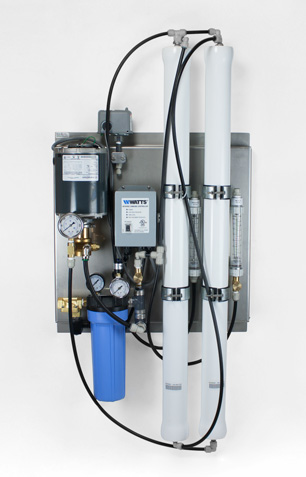
This page presents only one of many large reverse osmosis units available through Pure Water Products from Watts, one of the nation's premier makers of large reverse osmosis units.
We like the R-12 because of its simplicity and ease of installation and operation. It is ideal for most residential applications.
The R-12 is basic RO at its best: tough and reliable, with standard-sized components, designed for years of reliable service. You will appreciate the use of standard-sized components when it comes time to replace a part. For example, the R-12 uses an easy to find 2.5" X 40" membrane. When you replace it, you will have lots of brand and price options that aren't available with proprietary units for which the manufacturer requires you to buy his brand at his price. Pumps and motors are also standard industry items that you can purchase from a variety of sources.
The R-12 is perfectly sized for most home users. We offer it in two production sizes — 600 and 1200 gallons per day. The units are identical, except that the 1200 gallon unit has two membranes and the 600 has one.
Specifications
Measurements:
22" wide
52" tall
12" deep
(600 & 1200 gallon-per-day units have the same measurements.)
Both inlet and reject water connections are with 3/8" plastic tubing.
The unit runs on standard 120 volt/60 hz house current. 8 Amps.
Minimum feed water requirement is 2.4 gallons-per-minute at 10 PSIG.
Maximum drain capacity needed is 2.4 gallons-per-minute.
The units use either one or two 2.5" X 40" reverse osmosis membranes and recovery rate is up to 50%. It has an adjustable recycle system to reuse some of the reject water.
Standard Features
- High-rejection thin film membrane(s).
- Stainless steel frame and membrane housing(s).
- High-pressure Procon pump and 1/2 HP motor.
- Liquid filled pressure gauges for inlet and concentrate.
- Low pressure shutoff with automatic restart in the event of low inlet pressure.
- Flow meters on both product water (permeate) and reject water (concentrate, brine).
- Pressure regulator valves.
- Heavy duty pressure tubing.
- Brine recycle system controlled by a simple needle valve.
- Stainless steel check valve for permeate line.
- Solenoid valves for pump and flush.
- Factory tested and sterilized.
- Comprehensive limited warranty.
- A simple design that's easy to understand, easy to install, and easy to service.
Watts R-12 600 and 1200 GPD Units
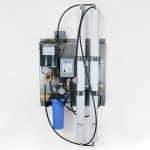
Go here for help in sizing a whole house R.O. system.
Watts “Whole House Option” Installation Package
Watts “Whole House Option” for R-12 RO Units includes virtually everything you need for a complete installation, including a storage tank with bulkhead fittings, pre-wired float switch, and Grundfos repressurization pump. The top-quality Grundfos pump offers the great advantage that it can be installed without an additional pressure tank.
This system works for both 600 and 1200 gallon per day units.
Optional Upgrades
If you're running your RO unit on relatively clean water, this feature is probably not needed. However, if the TDS of the water you're treating is high, this feature will be more than worth the expense.
The purpose of the auto-flush feature is to flush the membrane upon startup and periodically thereafter. It can make a remarkable difference in performance and membrane longevity if your dissolved solids level is high. It can add greatly to the lifespan of membranes, and it can significantly improve the unit's TDS rejection performance.
R-12 units are designed for wall mounting. If you prefer a free-standing installation, however, order this stainless steel leg kit. Works for 600 or 1200 gallon models.
Gives separate TDS readings of both incoming and product water. Includes all mounting hardware, fittings, and instructions. Can be ordered as an option to either the 1200 gallon or 600 gallon Watts R12 unit. Batteries included.
Note: A TDS tester is an absolutely necessary tool for maintaining a reverse osmosis unit. However, you can get by with a less expensive, hand-held tester. (See our "RO Parts" page for hand-held testers.)
Replacement Parts for Watts R-12 RO Units
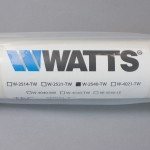
Pre-Treatment for Large RO Units
Here are some product suggestions for pre-treatment. This is not intended as a complete discussion but as a reference to pages on our site where you can find more information and purchase pre-treatment products. We welcome calls and emails requesting more information on these issues.
Sediment can be removed either with a cartridge-style filter such as our System A unit or by a backwashing filter. Zeolite, Filter Ag, and Multi-Media are common sediment removal media.
Iron can be removed by Filox or Birm filters. You may need to pre-treat for the filter an oxidizer such as aeration or chlorination. Iron in small amounts can also be reduced with a water softener. For RO pre-treatment, twin softeners are preferred, because they can provide an uninterrupted flow of treated water. (Please call (888) 382-3814 for information about twin softeners.)
Hardness is best treated by a water softener, but alternatives like poly-phosphate injection and alternative scale prevention systems are sometimes used. As stated above, twin softeners work best with RO units because an uninterrupted supply of softened water is required.
Chlorine can be removed with any good carbon filter — either a carbon block or a backwashing GAC unit.
Post-Treatment for Large RO Units
The standard way to increase pH after a reverse osmosis unit is with a backwashing calcite filter. For smaller, non-backwashing calcite tanks, please call (888) 382-3814.
The Watts “Whole House Option”
The “whole house option” for large RO units is a product that's long overdue. It takes the guesswork out of planning a whole house installation. Except for incidentals specific to your application, which are hardware store items, it has everything you need to store the water made by the RO unit and send it to your home.
The whole house option comes with an atmospheric storage tank. Three tank sizes are available. 300 gallons is an ideal size for most residential whole house installations. The tank is pre-fitted with three bulkhead fittings, and the RO shutoff float valve is preinstalled, so that you just have to plug the RO unit into the electrical outlet on the float switch and plug the float switch into a standard 115 volt AC outlet and you're ready to go.
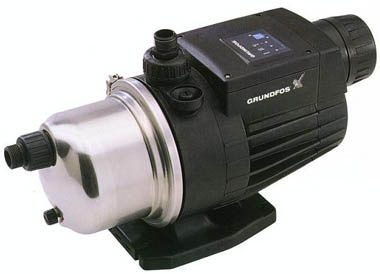
Grundfos MQ3 Pump
The delivery pump is the superior, self-priming Grundfos MQ3-45 110-120 volt 1 HP pump. The complete-in-itself MQ3 takes all the worry out of pump setup. You won't need a separate pressure tank, which more basic repressurization pumps require, and you won't need a pressure switch, additional electrical connections or fittings, or any of the other accessory items pump installation usually requires. Very easy to set up and operate, the MQ3 features a user-friendly control panel that has everything you need to get the pump up and running quickly. The pump has its own small built-in pressure tank to assure smooth, instant delivery of water upon demand. The check valve is also built into the pump. The pump is protected from an empty storage tank by a built-in dry run protection feature which automatically shuts off the pump if no water is available and even has an automatic restart feature to restore the pump to service when water is available.
You won't find a better, more durable, or easier to operate delivery pump.
Site Index
Filtration Systems
- Aeration for Iron & Sulfide
- Backwashing Filters
(whole house & well units)
- Chlorine & Chemical Injectors
- Countertop Water Filters
- Emergency Filters
- Garden Hose Filters
- Reverse Osmosis, Residential
- Reverse Osmosis, Commercial
- Shower Filters
- Specialty Filters
- Ultraviolet Systems
- Undersink Filters
- Water Softeners
- Whole House Filters
Cartridges
Parts
- Replacement Parts
- Faucets
- Filter Media
- Fittings
- Housings
- O-rings
- Pumps
- Pura UV
- R.O. Parts
- R.O. Tanks
- R.O. Booster Pump
- VIQUA UV
